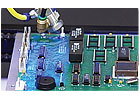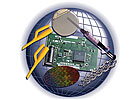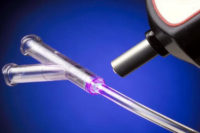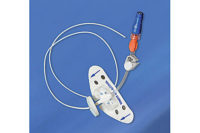Conformal coatings protect electronic assemblies from the elements.

It’s April, and here in the Midwest at least, that means you’d be wise to have a raincoat and a stout umbrella if you don’t want to get soaked.
Many electronic assemblies need protection from the elements, too. Conformal coatings shield electronic assemblies from thermal shock, moisture, humidity, corrosion, fungus, dust, dendrite growth, oxidation and even handling during final assembly.
Conformal coatings do more than just keep electronic products dry. These polymer coatings strengthen delicate components and leads and support small devices that can’t be mechanically secured. Because they are electrically insulative, conformal coatings prevent current leakage and inhibit arcing. This is a great benefit to electronics designers who face the challenge of packing more power and capability into an ever-shrinking footprint.
A variety of polymers can be used as conformal coatings. The most common chemistries are acrylics, epoxies, Parylenes, silicones and urethanes. Less common polymers include amorphous fluoropolymers, fluorocarbons and perfluoroethers. Many coatings are hybrids of two or more of these chemistries. Most are produced as traditional, solvent-based materials, but some are available in solvent-free formulations.
Acrylics are relatively hard with a smooth, glossy finish. They are one of the easiest coatings to handle: They are easy to apply and dry quickly. They do not require a curing process, and can easily be removed with solvents. Acrylics resist moisture as well as urethanes and silicones. They have moderate abrasion resistance, but are not so good at withstanding heat, alcohol or petroleum solvents. They form a thin, tough shield, but are best used where environmental exposure is minimal. Because they lack resistance to solvents, acrylics are easily reworked. Adhesion problems can occur if the substrate is not 100 percent clean and dry. Acrylics provide good dielectric protection and have a temperature range of –59 to 132 C.
Epoxies are typically two-part thermoset materials. They offer good humidity resistance and high abrasion resistance. They resist all solvents and adhere strongly to most surfaces. Epoxies form a hard, smooth surface that resists chipping, peeling or cracking. A drawback to epoxies is that they shrink while curing. This may stress components, so engineers should take that into account when designing their boards. Due to their extreme solvent resistance, epoxies are virtually impossible to strip. If rework must be done, it typically requires a soldering iron.
Parylenes are a unique family of coatings. Applied through vacuum deposition, these polymers form a strong, ultrathin, pinhole-free coating. The vacuum deposition process applies a uniform coating of Parylene to every area on the assembly-even hidden surfaces that other coatings can’t reach. As such, contact points such as battery contacts or connectors must be carefully masked. Parylenes do not contain solvents or catalysts, and require no curing.
Parylenes have excellent dielectric strength, high thermal stability (up to 450 C), and outstanding chemical resistance. They protect circuits against high humidity, intermittent immersion, fog, pollution and aggressive solvents. They’re also biocompatible and biostable, making them suitable for use with medical devices.
Rework of Parylenes is possible. Removal methods include microabrasive blasting, incising, excimer laser etching, heat softening and plasma etching. Areas from which Parylene has been removed can be recoated to their original specifications.
Silicones have good electrical insulation properties, making them suitable for high power and highly populated boards. Once cured, silicones are pliable. Their adhesive strength ranges from easily detachable to tightly bonded. They have good resistance to moisture, humidity, heat and ultraviolet light.
Because they’re so flexible, silicones can be applied much thicker than other materials. They can withstand expansion and contraction without transmitting this stress to underlying components. Silicones are available in solvent-resistant and solvent-removable forms. Customized solvents are typically required to remove the former. The latter are removed more easily.
Urethanes are available in one- or two-part chemistries. Some are more difficult to apply, but all are very durable and provide a smooth, nonporous surface. They have good humidity and chemical resistance, and high dielectric properties. Urethanes provide similar moisture protection as acrylics and silicones. Hardness can range from extremely hard to relatively soft.
One-part urethanes are easier to apply, but may require a long cure time. Some two-component urethanes cure quickly. However, significant shrinkage can occur while curing, and the extremely hard film may stress components. Heat from a soldering iron will make urethanes pliable enough to remove, but workers should take precautions to avoid exposure to isocyanides, which can irritate the skin, nose and eyes.
Choosing the best coating for a particular application can be confusing. It’s a good idea to consult a few vendors to learn the benefits and limitations of the various chemistries. Test and compare a sample of each coating on your application before making a final selection. This up-front work will ensure that you protect your device with the best coating available.

Parylene is biocompatible and biostable, so it’s suitable for coating medical devices.
Application Methods
A brush is the oldest and simplest method of applying conformal coatings. The coating is applied to the brush and then painted onto the assembly. Like all manual processes, results are operator-dependent. Depending on the coating, the brush method can present a hazard to the operator. Manual masking and demasking is required to protect areas that should not be coated.Dip coating can be done manually or automatically. With this method, the assembly is submerged in a vat of coating material. When no bubbles come to the surface, the assembly is removed. This sounds simple, but in truth, the speed of immersion, the dwell time, and the speed and angle of removal from the vat must be precisely controlled to obtain an even, quality coating.
Like brush coating, manually dipping assemblies is operator-dependent and presents potential health hazards. As a result, the process is usually done automatically. With a machine, the operator can set speeds, angles and dwell times. However, assemblies still must be loaded and unloaded manually, and special tooling is needed to hold each assembly. And, whether the assemblies are dipped by hand or with a machine, manual masking and demasking is required.
Conformal coatings can also be sprayed onto assemblies. Like dip coating, this can be done manually or automatically. For small jobs, the coating can be dispensed from a small, handheld aerosol can. For larger jobs, a spray gun can be used inside an enclosed booth. Both methods are hard to control and are prone to “shadowing”-the formation of voids under components. Overspray is also an issue. The health hazards of manual spraying are obvious, and manual masking and demasking is required.
As a result, spraying is most often done with semiautomatic or fully automatic equipment. Selective spraying with automatic equipment allows assemblers to apply coatings with great precision and edge definition. Most selective coating systems provide closed-loop control over the material, the needle aperture, and the movement of the spray head. Such equipment doesn’t completely eliminate the need for masking, but it does greatly reduce it. Because the material is dispensed more precisely in an enclosed space, the process presents almost no hazard to the operator.
Some machines are equipped with more than one dispensing head to apply more than one material or coating pattern at the same time. An atomizing spray head can provide general coverage, while a needle dispenser can inject the coating into deep recesses and around tall components. Each head can move simultaneously in all three axes, with angular deflection of up to 30 degrees to reach all surfaces on an assembly.
Automatic coating equipment can be linked to a shop floor network for off-line programming and statistical process control. With an integrated a bar code reader, the coating machine can identify specific products on the line and automatically adjust process parameters, such as conveyor width, coating speed and dispense pattern.
Vacuum deposition is a unique coating process, in which the coating grows on the substrate one molecule at a time. The devices to be coated are placed in one vacuum chamber, and a powdered raw material, known as a dimer, is placed in another. The dimer is heated, causing it to sublimate into a monomeric vapor. This vapor is then transferred into the first chamber, where it condenses onto the parts, forming a thin film. No solvents, catalysts or plasticizers are required.

Most conformal coatings are sprayed onto electronic assemblies using semiautomatic or fully automatic equipment.
Choosing a Coating
There are many variables to consider when choosing a conformal coating. No single coating is right for every application. Before contacting vendors, engineers should ask themselves the following questions:* What are you protecting your electronics from?
* What temperature range will your electronics need to survive?
* What is the desired life of the product?
* How will the coating be applied?
* How important is ease of processing and curing?
* Are you coating one product or a mix of products?
* Can the design of the product be modified to facilitate the coating process?
* Are the electrical, chemical and mechanical attributes of the coating compatible with all parts of the assembly or will masking be required?
* Does the coating need to be biocompatible?
* How fast does the material cure?
* Can the material be reworked?
* Does the material present safety or disposal concerns?
Adhesion is the most important feature of any coating material. If the material does not adhere well, moisture can penetrate the substrate. Several factors affect adhesion, including incompatibility with the substrate and component materials, and residues from flux and cleaning solutions.
Lead-free electronics assemblies can present a special challenge to conformal coating. That’s because lead-free solder reflows at much higher temperatures than tin-lead solder. As a result, a variety of ionic contaminants tend to leach out from the assembly. These electrically conductive residues come from cleaners, etchants, plating, fluxes, human contact and the components themselves. To prevent product failure, these contaminants must be cleaned or they will be sealed to the board during coating.


